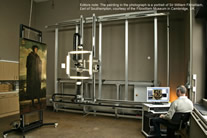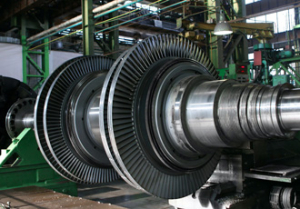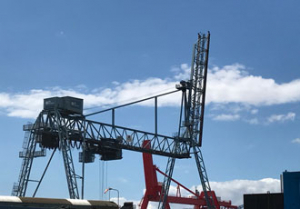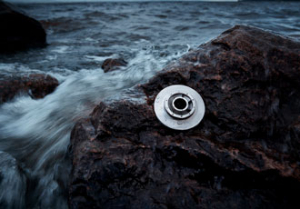STANDARD AUTOMATION COMPONENTS ACHIEVE MICRON POSITIONING ACCURACY
16th February 2010
Source:
HepcoMotion

A new, fully automated, fine art infrared scanning system isn’t just a prime example of what modern technology can achieve. It also shows how a scientific tool with micron positioning accuracy can be created from standard industrial automation components. The system is the brainchild of motion control specialist, SmartDrive®. Working in league with the linear motion company, HepcoMotion®, it has optimised the process of infrared scanning, greatly extending the scope of the technology. And the benefits of the system aren’t confined to infrared. The system control and specifically developed image stitching software also enables distortion-free digital photographs of large works to be taken for further study and record. For the art conservation world this system represents a significant imaging breakthrough.
The SmartDrive system is called SatScan and as its name implies the technology mimics that used in mapping systems with the optics ‘flying’ over or across the subject. Imagine zooming around Manhattan in Google Earth. What you see are the square roof tops, no shear sides of adjacent buildings. This is because small images are taken from a perpendicular position and then stitched. SatScan works in a similar way by moving digital and infrared camera heads incrementally around the artwork using encoder technology to achieve precision positioning.
“We know the position of the carriage to within ±1 micron,” explains the system’s designer, Dennis Murphy, Managing Director of SmartDrive. “We’re achieving this from automation components with industrial tolerances of 100 – 200 microns. In scientific terms we are also using relatively low resolution, off-the-shelf cameras. But by acquiring a small field of view – maybe just an inch or two square – and holding it perpendicular to the painting we can take images that are completely distortion free.”
The important aspect here is that each image has uniform scale throughout so valid measurements can be taken anywhere on the complete constructed image. Also the scale makes individual tiles easier to match and automatically join in software. The user can select the digital quality by adjusting the camera lens, in the fully zoomed mode the resolution of the system can create images at over one thousand DPI over a large area. Using a single shot from the best digital camera available cannot match the SatScan’s clarity and will always suffer from parallax issues creating distortion on the resultant image. “SatScan is a solid proven digital technique that provides great application flexibility and stunning results.” Dennis adds
The first large scale SatScan is installed at the Hamilton Kerr Institute near Cambridge, a centre of excellence for conservation services that is world renowned for its work on tempura easel paintings. It provided the expert knowledge needed for the art version of the SatScan development and is now using the system on a daily basis. Infrared imaging is just one of a range of tools used by the Institute’s conservators and is primarily used to see any under-drawings on the canvas or to examine previous re-touching. For example it will show if an egg tempura painting has been retouched with oils. The information it provides guides the restoration process and also enriches the history of the work. It can also help with authentication by revealing details that may show consistency with a certain artist.
Another important area of work for the Hamilton Kerr Institute is research into the care of works of art. Paintings and the public thrive in very different environments so the Institute provides expert advice to the keepers of our national collections on how best to strike a compromise.
Historically infrared scanning at the Institute has been a time consuming and costly exercise. Even the latest generation equipment had significant pitfalls. It involved manually moving a Vidicon analogue TV camera into position, capturing a small infrared image and then uploading it using manual stitching software. “Imaging even a small painting was a day’s work using this method,” explains Chris Titmus imaging consultant at Hamilton Kerr. “And even then the complete image wasn’t clean, as stitching was by eye and the edges of most images were blurred.”
A further problem with the old system was the danger of image burning onto the camera tube, necessitating regular replacement and adding to the process cost. “Just having the camera switched on would cost in the region of £30 per hour,” Chris adds.
The new SatScan system is completely automatic. “Once the work is in position we press a button, the image capture process begins and the software stitches it all together,” Chris continues. “In an hour or so we can achieve what used to require a whole day. Indeed the system is also allowing us to take on work we wouldn’t have considered before. In the past it would only have been viable to look at selected areas of some paintings whereas now we can examine the whole thing.”
Another major benefit is the size of the painting or alter piece that can be scanned by the system. The Hamilton Kerr Institute recently used SatScan to image a painted oak panel that was two inches thick and seven feet tall. It was simply a matter of moving it in its wheeled frame to a position in front of the system. The Institute specialises in subjects of this scale so the reduced handling involved ensures the safety of both the artwork and the conservator.
The computing power that is now readily available is perhaps the single most important factor in the development of SatScan. This has allowed SmartDrive® to use off-the-shelf components to create this bespoke system. The source of all the mechanical elements for the system was SmartDrive’s longstanding partner, HepcoMotion®. However, this linear motion specialist wasn’t just responsible for product supply. Having taken an outline brief from SmartDrive, HepcoMotion® designed the system mechanics on 3D CAD. It then built and thoroughly tested the system at its factory in Tiverton, Devon.
Creating sub-assemblies and indeed complete automation systems of this type is now a very important strand of the HepcoMotion® business. It provides small manufacturers with a low risk automation strategy as its systems are guaranteed fit for purpose. “We work with HepcoMotion® a lot and have commissioned many successful joint projects, we know the range well but we needed to call their specialist knowledge on this project,” Dennis Murphy explains. “Whilst the system load is small, about 20kg for lights and the camera, we needed a large frame to accommodate large works of art. The HKI SatScan is designed to scan areas of 4.5m x 3.5m. This makes for a large installation and its metalwork – mostly aluminium extrusion – weighs over 400 kg. The HepcoMotion® technical team designed a strong lightweight frame that was capable of handling the inertia of such a moving load yet maintains rigidity so that “wobble” is minimised and the micron positioning of the cameras that is so crucial is not compromised. Furthermore we had to ensure everything was sufficiently robust, especially given the value of many of the subjects involved.”
The HepcoMotion® SBD was selected for carrying the camera heads in both the horizontal and vertical axes. This sealed belt drive is designed for high loads and demanding duty cycles and provides an exceptionally clean linear solution. Each of the guideways is fitted with a scale and optical read head to provide positioning feedback. The high strength, aluminium SBD units are mounted onto the SatScan gantry that is made from the HepcoMotion® MCS machine construction system. A small HepcoMotion® GV3 guideway was chosen to provide fine adjustment of camera carriage in the Z axis. Further HepcoMotion® components included the ZIMM screwjacks that are responsible for adjusting the incline angle of the 4.5m x 3.5m frame to accord with the painting. The entire system was built at the HepcoMotion® factory in Tiverton and the elements then transported to SmartDrive® for cabling and the integration of the drives and controls. The working unit is located in a busy studio with typically three or four people working in close proximity, despite its scale the system emits no more than a pleasing hum as it automatically sets about its business of gathering high resolution data.
SmartDrive® called on all their 21 years of motion control expertise to design the system capable of precise motion on such a large scale. This involved the careful consideration of load/motor inertia matching and the use of precision SmartDrive Taranis® technology digital drives, the combination of which produces smooth quiet and accurate motion. The compa
“We know the position of the carriage to within ±1 micron,” explains the system’s designer, Dennis Murphy, Managing Director of SmartDrive. “We’re achieving this from automation components with industrial tolerances of 100 – 200 microns. In scientific terms we are also using relatively low resolution, off-the-shelf cameras. But by acquiring a small field of view – maybe just an inch or two square – and holding it perpendicular to the painting we can take images that are completely distortion free.”
The important aspect here is that each image has uniform scale throughout so valid measurements can be taken anywhere on the complete constructed image. Also the scale makes individual tiles easier to match and automatically join in software. The user can select the digital quality by adjusting the camera lens, in the fully zoomed mode the resolution of the system can create images at over one thousand DPI over a large area. Using a single shot from the best digital camera available cannot match the SatScan’s clarity and will always suffer from parallax issues creating distortion on the resultant image. “SatScan is a solid proven digital technique that provides great application flexibility and stunning results.” Dennis adds
The first large scale SatScan is installed at the Hamilton Kerr Institute near Cambridge, a centre of excellence for conservation services that is world renowned for its work on tempura easel paintings. It provided the expert knowledge needed for the art version of the SatScan development and is now using the system on a daily basis. Infrared imaging is just one of a range of tools used by the Institute’s conservators and is primarily used to see any under-drawings on the canvas or to examine previous re-touching. For example it will show if an egg tempura painting has been retouched with oils. The information it provides guides the restoration process and also enriches the history of the work. It can also help with authentication by revealing details that may show consistency with a certain artist.
Another important area of work for the Hamilton Kerr Institute is research into the care of works of art. Paintings and the public thrive in very different environments so the Institute provides expert advice to the keepers of our national collections on how best to strike a compromise.
Historically infrared scanning at the Institute has been a time consuming and costly exercise. Even the latest generation equipment had significant pitfalls. It involved manually moving a Vidicon analogue TV camera into position, capturing a small infrared image and then uploading it using manual stitching software. “Imaging even a small painting was a day’s work using this method,” explains Chris Titmus imaging consultant at Hamilton Kerr. “And even then the complete image wasn’t clean, as stitching was by eye and the edges of most images were blurred.”
A further problem with the old system was the danger of image burning onto the camera tube, necessitating regular replacement and adding to the process cost. “Just having the camera switched on would cost in the region of £30 per hour,” Chris adds.
The new SatScan system is completely automatic. “Once the work is in position we press a button, the image capture process begins and the software stitches it all together,” Chris continues. “In an hour or so we can achieve what used to require a whole day. Indeed the system is also allowing us to take on work we wouldn’t have considered before. In the past it would only have been viable to look at selected areas of some paintings whereas now we can examine the whole thing.”
Another major benefit is the size of the painting or alter piece that can be scanned by the system. The Hamilton Kerr Institute recently used SatScan to image a painted oak panel that was two inches thick and seven feet tall. It was simply a matter of moving it in its wheeled frame to a position in front of the system. The Institute specialises in subjects of this scale so the reduced handling involved ensures the safety of both the artwork and the conservator.
The computing power that is now readily available is perhaps the single most important factor in the development of SatScan. This has allowed SmartDrive® to use off-the-shelf components to create this bespoke system. The source of all the mechanical elements for the system was SmartDrive’s longstanding partner, HepcoMotion®. However, this linear motion specialist wasn’t just responsible for product supply. Having taken an outline brief from SmartDrive, HepcoMotion® designed the system mechanics on 3D CAD. It then built and thoroughly tested the system at its factory in Tiverton, Devon.
Creating sub-assemblies and indeed complete automation systems of this type is now a very important strand of the HepcoMotion® business. It provides small manufacturers with a low risk automation strategy as its systems are guaranteed fit for purpose. “We work with HepcoMotion® a lot and have commissioned many successful joint projects, we know the range well but we needed to call their specialist knowledge on this project,” Dennis Murphy explains. “Whilst the system load is small, about 20kg for lights and the camera, we needed a large frame to accommodate large works of art. The HKI SatScan is designed to scan areas of 4.5m x 3.5m. This makes for a large installation and its metalwork – mostly aluminium extrusion – weighs over 400 kg. The HepcoMotion® technical team designed a strong lightweight frame that was capable of handling the inertia of such a moving load yet maintains rigidity so that “wobble” is minimised and the micron positioning of the cameras that is so crucial is not compromised. Furthermore we had to ensure everything was sufficiently robust, especially given the value of many of the subjects involved.”
The HepcoMotion® SBD was selected for carrying the camera heads in both the horizontal and vertical axes. This sealed belt drive is designed for high loads and demanding duty cycles and provides an exceptionally clean linear solution. Each of the guideways is fitted with a scale and optical read head to provide positioning feedback. The high strength, aluminium SBD units are mounted onto the SatScan gantry that is made from the HepcoMotion® MCS machine construction system. A small HepcoMotion® GV3 guideway was chosen to provide fine adjustment of camera carriage in the Z axis. Further HepcoMotion® components included the ZIMM screwjacks that are responsible for adjusting the incline angle of the 4.5m x 3.5m frame to accord with the painting. The entire system was built at the HepcoMotion® factory in Tiverton and the elements then transported to SmartDrive® for cabling and the integration of the drives and controls. The working unit is located in a busy studio with typically three or four people working in close proximity, despite its scale the system emits no more than a pleasing hum as it automatically sets about its business of gathering high resolution data.
SmartDrive® called on all their 21 years of motion control expertise to design the system capable of precise motion on such a large scale. This involved the careful consideration of load/motor inertia matching and the use of precision SmartDrive Taranis® technology digital drives, the combination of which produces smooth quiet and accurate motion. The compa
Similar articles
More from HepcoMotion
- The Ultimate Flexibility In Workbench And Storage System Design 2nd April 2013
- Linear Motion Carriages For High Offset Loads 28th August 2012
- NEW RANGE OF TIMING BELT RING SLIDES, PULLEYS AND BELTS 21st December 2011
- Linear product for innovative packaging machinery 13th December 2011

-(1)ed.jpg)










Write a comment
No comments